The 1918 Flu Pandemic: Why It Matters 100 Years Later
Posted on by100 years ago, an influenza (flu) pandemic swept the globe, infecting an estimated one-third of the world’s population and killing at least 50 million people. The pandemic’s death toll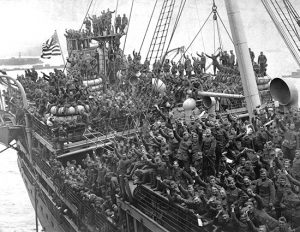 was greater than the total number of military and civilian deaths from World War I, which was happening simultaneously. At the time, scientists had not yet discovered flu viruses, but we know today that the 1918 pandemic was caused by an influenza A (H1N1) virus. The pandemic is commonly believed to have occurred in three waves. Unusual flu-like activity was first identified in U.S. military personnel during the spring of 1918. Flu spread rapidly in military barracks where men shared close quarters. The second wave occurred during the fall of 1918 and was the most severe. A third wave of illness occurred during the winter and spring of 1919.
was greater than the total number of military and civilian deaths from World War I, which was happening simultaneously. At the time, scientists had not yet discovered flu viruses, but we know today that the 1918 pandemic was caused by an influenza A (H1N1) virus. The pandemic is commonly believed to have occurred in three waves. Unusual flu-like activity was first identified in U.S. military personnel during the spring of 1918. Flu spread rapidly in military barracks where men shared close quarters. The second wave occurred during the fall of 1918 and was the most severe. A third wave of illness occurred during the winter and spring of 1919.
Here are 5 things you should know about the 1918 pandemic and why it matters 100 years later.
1. The 1918 Flu Virus Spread Quickly
500 million people were estimated to have been infected by the 1918 H1N1 flu virus. At least 50 million people were killed around the world including an estimated 675,000 Americans. In fact, the 1918 pandemic actually caused the average life expectancy in the United States to drop by about 12 years for both men and women.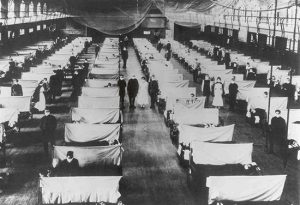
In 1918, many people got very sick, very quickly. In March of that year, outbreaks of flu-like illness were first detected in the United States. More than 100 soldiers at Camp Funston in Fort Riley Kansas became ill with flu. Within a week, the number of flu cases quintupled. There were reports of some people dying within 24 hours or less. 1918 flu illness often progressed to organ failure and pneumonia, with pneumonia the cause of death for most of those who died. Young adults were hit hard. The average age of those who died during the pandemic was 28 years old.
2. No Prevention and No Treatment for the 1918 Pandemic Virus
In 1918, as scientists had not yet discovered flu viruses, there were no laboratory tests to detect, or characterize these viruses. There were no vaccines to help prevent flu infection, no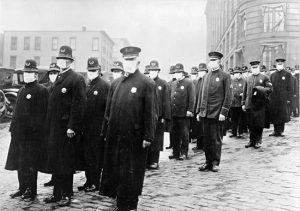 antiviral drugs to treat flu illness, and no antibiotics to treat secondary bacterial infections that can be associated with flu infections. Available tools to control the spread of flu were largely limited to non-pharmaceutical interventions (NPI’s) such as isolation, quarantine, good personal hygiene, use of disinfectants, and limits on public gatherings, which were used in many cities. The science behind these was very young, and applied inconsistently. City residents were advised to avoid crowds, and instructed to pay particular attention to personal hygiene. In some cities, dance halls were closed. Some streetcar conductors were ordered to keep the windows of their cars open in all but rainy weather. Some municipalities moved court cases outside. Many physicians and nurses were instructed to wear gauze masks when with flu patients.
antiviral drugs to treat flu illness, and no antibiotics to treat secondary bacterial infections that can be associated with flu infections. Available tools to control the spread of flu were largely limited to non-pharmaceutical interventions (NPI’s) such as isolation, quarantine, good personal hygiene, use of disinfectants, and limits on public gatherings, which were used in many cities. The science behind these was very young, and applied inconsistently. City residents were advised to avoid crowds, and instructed to pay particular attention to personal hygiene. In some cities, dance halls were closed. Some streetcar conductors were ordered to keep the windows of their cars open in all but rainy weather. Some municipalities moved court cases outside. Many physicians and nurses were instructed to wear gauze masks when with flu patients.
3. Illness Overburdened the Health Care System
An estimated 195,000 Americans died during October alone. In the fall of 1918, the United States experienced a severe shortage of professional nurses during the flu pandemic because large numbers of them were deployed to military camps in the United States and abroad.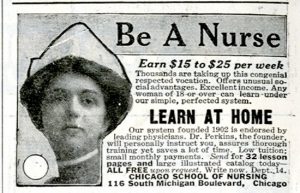 This shortage was made worse by the failure to use trained African American nurses. The Chicago chapter of the American Red Cross issued an urgent call for volunteers to help nurse the ill. Philadelphia was hit hard by the pandemic with more than 500 corpses awaiting burial, some for more than a week. Many parts of the U.S. had been drained of physicians and nurses due to calls for military service, so there was a shortage of medical personnel to meet the civilian demand for health care during the 1918 flu pandemic. In Massachusetts, for example, Governor McCall asked every able-bodied person across the state with medical training to offer their aid in fighting the outbreak.
This shortage was made worse by the failure to use trained African American nurses. The Chicago chapter of the American Red Cross issued an urgent call for volunteers to help nurse the ill. Philadelphia was hit hard by the pandemic with more than 500 corpses awaiting burial, some for more than a week. Many parts of the U.S. had been drained of physicians and nurses due to calls for military service, so there was a shortage of medical personnel to meet the civilian demand for health care during the 1918 flu pandemic. In Massachusetts, for example, Governor McCall asked every able-bodied person across the state with medical training to offer their aid in fighting the outbreak.
As the numbers of sick rose, the Red Cross put out desperate calls for trained nurses as well as untrained volunteers to help at emergency centers. In October of 1918, Congress approved a $1 million budget for the U. S. Public Health Service to recruit 1,000 medical doctors and more than 700 registered nurses.
At one point in Chicago, physicians were reporting a staggering number of new cases, reaching as high as 1,200 people each day. This in turn intensified the shortage of doctors and nurses. Additionally, hospitals in some areas were so overloaded with flu patients that schools, private homes and other buildings had to be converted into makeshift hospitals, some of which were staffed by medical students.
4. Major Advancements in Flu Prevention and Treatment since 1918
The science of influenza has come a long way in 100 years! Developments since the 1918 pandemic include vaccines to help prevent flu, antiviral drugs to treat flu illness, antibiotics to treat secondary bacterial infections such as pneumonia, and a global influenza surveillance system with 114 World Health Organization member states that constantly monitors flu activity. There also is a much better understanding of non-pharmaceutical interventions–such as social distancing, respiratory and cough etiquette and hand hygiene–and how these measures help slow the spread of flu.
Developments since the 1918 pandemic include vaccines to help prevent flu, antiviral drugs to treat flu illness, antibiotics to treat secondary bacterial infections such as pneumonia, and a global influenza surveillance system with 114 World Health Organization member states that constantly monitors flu activity. There also is a much better understanding of non-pharmaceutical interventions–such as social distancing, respiratory and cough etiquette and hand hygiene–and how these measures help slow the spread of flu.
There is still much work to do to improve U.S. and global readiness for the next flu pandemic. More effective vaccines and antiviral drugs are needed in addition to better surveillance of influenza viruses in birds and pigs. CDC also is working to minimize the impact of future flu pandemics by supporting research that can enhance the use of community mitigation measures (i.e., temporarily closing schools, modifying, postponing, or canceling large public events, and creating physical distance between people in settings where they commonly come in contact with one another). These non-pharmaceutical interventions continue to be an integral component of efforts to control the spread of flu, and in the absence of flu vaccine, would be the first line of defense in a pandemic.
5. Risk of a Flu Pandemic is Ever-Present, but CDC is on the Frontlines Preparing to Protect Americans
Four pandemics have occurred in the past century: 1918, 1957, 1968, and 2009. The 1918 pandemic was the worst of them. But the threat of a future flu pandemic remains. A pandemic flu virus could emerge anywhere and spread globally.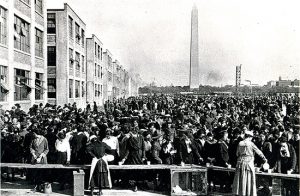
CDC works tirelessly to protect Americans and the global community from the threat of a future flu pandemic. CDC works with domestic and global public health and animal health partners to monitor human and animal influenza viruses. This helps CDC know what viruses are spreading, where they are spreading, and what kind of illnesses they are causing. CDC also develops and distributes tests and materials to support influenza testing at state, local, territorial, and international laboratories so they can detect and characterize influenza viruses. In addition, CDC assists global and domestic experts in selecting candidate viruses to include in each year’s seasonal flu vaccine and guides prioritization of pandemic vaccine development. CDC routinely develops vaccine viruses used by manufacturers to make flu vaccines. CDC also supports state and local governments in preparing for the next flu pandemic, including planning and leading pandemic exercises across all levels of government. An effective response will diminish the potential for a repeat of the widespread devastation of the 1918 pandemic.
Visit CDC’s 1918 commemoration website for more information on the 1918 pandemic and CDC’s pandemic flu preparedness work.
63 comments on “The 1918 Flu Pandemic: Why It Matters 100 Years Later”
Comments listed below are posted by individuals not associated with CDC, unless otherwise stated. These comments do not represent the official views of CDC, and CDC does not guarantee that any information posted by individuals on this site is correct, and disclaims any liability for any loss or damage resulting from reliance on any such information. Read more about our comment policy ».


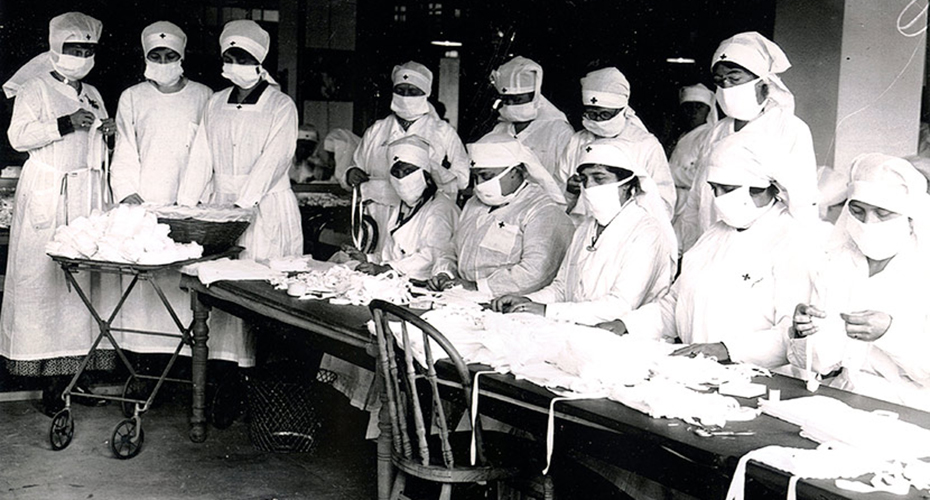
Hi,
Thank you for this article. Very informative. Maybe the people that do not understand and do not accept the vaccination campaign will change their minds.
Excellent historical perspective on the 1918 incident. We have come a long way in treatment protocols and diagnostic advancements with respect to infectious diseases. The major concern,at this time, is an unknown pathogen which will be quickly spread worldwide my international jet travel. A few sick people on an aircraft entering the US could easy spread the disease from one end of the Country to the other. Depending on the conditions’ incubation period many more people will be affected before public health officials begin to see a problem. I guess the only thing we can be sure of is something similar will occur again , it’s just a matter of the right conditions and time.
This is a wonderful article on the influenza virus. I have extensively read about the pandemic, and its devastating effect on people. I must admit that I am appalled at the refusal to use trained nurses because they were Black Americans. That nonsense was part of the failure to help people in need of care at this crucial time . I must say it was hateful and ignorant of White Americans. White Americans are not reminded enough that they are immigrants to America just like any other race that came to this country from another country. America does not belong to white people. I don’t believe sick people care who is attending to them when they are on the brink of death.
Well done article. However. You could include a list of historical accounts for
Further reading materials.
The possibility of another potential outbreak of any kind is a very scary and real test of how very little know. We indeed have come along way but still have a distance to go. .. Thank you for sharing this fascinating story.
Two of my grandparents were killed in their 30s by this epidemic, leaving my 1 year-old mother, my aunt, and my uncle orphaned. This is important stuff; people need to take influenza seriously.
My grandfather was a doctor in the Spokane Wa area and died from the flu in July of 1918 at age 46 . He was from the St Louis Missouri area and had been in the Spokane area for several years but could have visited or was visited by people from the St Louis area which is close to Kansas City to have caught the flu . Spokane was very isolated . This article gives no answer but gives some background to how he caught the flu in the middle of nowhere at the beginning of this pandemic
Would the mortality rate be as bad as the flu pandemic in 1918 where 675,000 people were killed? How would our economy be affected? Any thoughts?
The book “The Great Influenza” by John M. Barry has many historical references on this topic.
Good summary of the 1918 flu pandemic. But the sentence “The average age of those who died during the pandemic was 28 years old” (end of the first section) is inaccurate. Twenty-eight was the age at which mortality peaked among young adults, who were the hardest hit, along the very young and the very old. As for the average, variations in infant or old adult mortality could easily tip the balance away from 28 years.
In researching flu a few years ago, I read that one reason this flu killed people of supposedly optimum age for strength and resistance (~28 years), was for exactly that reason – their immune systems responded so quickly – with fluid in the lungs – that they drowned. People who responded more slowly, with less fluid produced less quickly – were more likely to survive.
By the way, if this thing posts (my first post ever on this site), I’m getting this message:
You are posting comments too quickly. Slow down.
(Please check your software)
I would agree with Tonya and Robert, there is an ever-present threat of a variant flu virus reeking havoc as many go unprepared for each flu season by not vaccinating, but also with a new, unknown pathogen. With the climate changing and the glacier ice melting to new low levels, bacteria, viruses and parasites previously encased in ice soon may be exposed to air, water, and humans. I am thankful for the diligent surveillance that the CDC and the WHO provides.
Thank you for that summary. The pandemic took my grandmother in the Spring of 1919. My father and his two sisters were orphans then. Their father had died in France, November 1918. It is always so sad for me to read about this.
Any plan to slow or stop a pandemic would include quickly identifying those who are contagious and minimizing their contact with others. However we do not have in place policies that would encourage that behavior, particularly in the low income and immigrant populations, including people who:
* cannot afford to take time off work without pay
* would lose their jobs if they did not show up
* have no health insurance and can’t afford medical care
* are afraid to seek care because of immigration status (their own or family member’s)
And anyone who was quarantined would want to know that their basic needs would be met if they complied.
I believe these issues would be best addressed in advance to overcome resistance. Once a potential pandemic starts, it will be difficult to get the necessary public and private buy-in, resources and authority until it is too late.
It’s surprising that to see that the first three items listed would apply to any similar pandemic of unknown origin today. Today’s air travel would spread an illness at previously unheard of rates. Couple that with an unknown origin and our health care systems would be over run just as they were in 1918.
Thank you so much for this article. I appreciate the information included and I pray that it convinces people with reservations to keep their own and their families health in mind for everyone’s sake but especially their own.
My grandmother was 11 years old in 1918. The family was from Philadelphia. I remember her telling me that she had to help load dead bodies into wagons. They would yell in the neighborhoods, “throw out your dead!” She never got the flu, but it must have been horrible!
That is why we were always told never to spit on the streets. It can carry diseases, etc.
People—Don’t think this cannot happen again. We live in an age where we can prevent the worst from happening when it comes to flu and other diseases.
Get your flu shots!
Very educative write-up. A big lesson for us in Africa. The surveillance of influenza viruses must be sustained especially at animal-human interface to monitor possible new mutations. Thank you.
My grandfather was 15 years old. His parents and his two siblings were very ill with the flu so he ran to get help. By the time he got back to the house they were all dead. I am lying in bed with the H1N1 right now. Probably the sickest I’ve ever been. I personally believe facemasks should be mandatory and all public transportation. What a tragedy all the way around.
Great information on the flu pandemic. Very educative and sad.
History has taught us much about various past outbreaks. It’s the future unknown pathogens manmade or natural we need to worry about.
Great article on the flu pandemic. I have done a lot of studying on the issue. John Barry has written many books about the pandemic
I find it incredible and riveting to learn about how people would wake up in the morning feeling fine and be dead in the evening. I have spoken to many people who experienced the flu through their families. I have always wondered if this can never happen again. Let’s hope not.
Great informative article thanks
I`ve just been watching THE LATEST NEWS ON THE 2020 CORONAVIRUS! making me wonder ??
I also remember COLLAPSING as I was walking down the street with HONG KONG FLU in 1956
Woke up in hospital…..TOOK MANY WEEKS TO RECOVER!!
while air travel will spread the virus faster today than before, the news of such virus is traveling even faster today, as can be seen in the current outbreak of 2019CoV. People around the world are in a state of panic as soon as it is reported. China did a total lock down pretty quickly. Nowadays, we get more information about the characteristics of the virus, like the temperature and humidity condition that is favorable/unfavorable to it, Scientists can produce a vaccine much sooner than before. So yes, we should be vigilant, but we do not need to be too scared to live our life normally.
Reading this in 2020, and it looks like the U.S. has not learned much.
those who do not know history are doomed to repeat it.
Actually, if you read how fast the flu spread, and how many died, some within 24 hours, we have come a long way! It took over 30 years to develop a flu vaccine, and within 3 months of coronavirus hitting, we have already started the clinical trials of a vaccine. Amazing!!
It’s like you saw into the future. The very not so distant future. Thanks for writing this as it reinforces the steps and procedures being followed today. If only they had been implemented sooner.
Here we go all over again
From this article I think WHO and CDC have not learned much to be in preparation. After 100 year another virus is here to take million lives away. Poor nation like Africa is in trouble. America should have known better to be prepare after 100years. God save us all
Apparently, there was no national plan then either. The lack of leadership by politicians on national and local levels is appalling and the realization that many top officials refuse to accept and follow recommendations of the CDC and other experts is terrifying. We are following exactly the same recommendations as were suggested in 1918, and there is inconsistent use of the precautions that we know help. Please support those who are taking the Coronavirus seriously and working to help us all. Bless the CDC and Drs and nurses on the front lines trying to save us all.
Great information
Watching the overrun hospitals, lack of supplies and reliance on local and state authorities because the federal government cannot or will not help. Schools are canceled. All groups more than 10 people. Social distancing rules are in place. The economy is crashing. No possible vaccine. History is repeating itself. I am literally hiding in my home with my family, knowing it’s the only way to avoid it.
Thank you for this article. It certainly puts the current COVID-19 pandemic in perspective, as well as reinforcing the need for social distancing! We are fortunate to live in a time when significant advances have been made in medicine and technology.
The CDC dropped the ball on this one, we need to shut down the country to prevent a worst case scenario. (writing this on 3/30/20) The economy will tank no matter what, but we can prevent millions of deaths yet.
My mother’s cousin was 21 when the 1918 influenza epidemic hit. He had cerebral palsy and was at risk for disease and he died. It’s hard though to comprehend how the influenza reached his tiny town outside of Abilene, Texas. There was very little medicine for colds or pneumonia for anyone in that time period.
100 years later viruses are still a problem.
Thank you
The history repeats itself, we can see USA as the richest country, powerful country, is so unprepared! Doctors and nurses are lacking of protective gears, yet they have to work with the patients who are infected with the virus! The States have to bid against one another for ventilators etc. So many people are infected and die from this neglected, unguided way ! So sad!
Very informative information and thanks to all those people that put this information together. It seems to be working for this coronavirus we are currently experiencing. Keep up the good work and lets try to do our best to improve what we have learned from this virus and make it better next time around as we can see …. there will be a next time …. just currently unknown as to when.
Sydney Daniels
Looking back at the comments in 2018 it is haunting. The accuracy of concerns and predictions! The rapid spread through international travel , the less privileged forced to continue working ,not only to perish but spread it. The fear of an unknown pathogen and it’s economic impact.
The parallels of past and present are too hard to ignore. The Spanish flu acting very similar to Coronavirus. There are several stories in the news of patients over 100, who were alive during the 1918 flu, surviving coronavirus. Is it a stretch to think whatever immunity they acquired back in 1918 could have given them an edge or are they just tough as nails!? Is it immunologically impossible being a different virus and the years past? Just a thought?
Unfortunately the reassurance, given in this article, that we have multiple guardrails in place to prevent such a huge spread again was wishful thinking. God bless everyone and stay safe.
My grandfather died from the Spanish flu and struck both my father and uncle as children. My father suffered cardiomyopathy and succumbed to it decades later. Financial struggles where perhaps worse since women had less legal rights and job opportunities that had any semblance of equal pay. My grandmother supported her family through a variety of seamstress jobs and cleaning for those that could afford that luxury. History is a good teacher if we can learn from it.
Watching the BOSSA. 45 min documentary on the spanish flu of 1918 so enlightening also. The symptoms of severe cases were bizarre and freakish, fatal in less than 24 hrs. A second wave (fall 2020) of covid must be minimized if world wants to prevent millions of deaths. Unfortunately, so many spoiled americans are selfish and very impatient willing to risk and sacrifice many others lives for a day at the beach or a new tattoo. If only they all could have done a 6 month sentence in county jail they would see that they could stomach months of quarantine in their own homes standing on their head, provided ample food and necessities are avialable.Too bad history will be repeated and this will be a disaster for so many more that shall lose their lives
here we go again!
102 years later and the struggles that our ancestors dealt with daily are being resurfaced again. As an RN working in the frontlines with the current flu pandemic, the level of stress that is experienced among health care workers is almost unbearable. Just as the 1918 flu was fast to spread with no prevention or treatment plan in place, this new outbreak is fast to spread and hard to treat and prevent. Taking a lesson from the 1918 pandemic, our facility took to making the staff and the patients wear mask for all interactions during their stay at our facility in an effort to reduce the risk of spreading patient to nurse or nurse to patient. The most unnerving concern to me personally is the fact that unlike the 1918 flu, an estimated 50% of individuals who have the COVID-19 virus have experienced zero symptoms. This makes the task of identifying the positive patients from simple screening procedures much more difficult due to lack of testing ability to confirm actual positive patients. For example, we had an elderly man in our facility for more than two weeks for an unrelated health care issue, screening upon admission declared he was a zero risk for COVID-19 and he never exhibited a single symptom during his admission, however upon discharge and transfer to a rehab facility, he had a COVID-19 positive test result. He continues to have ZERO symptoms but has exposed multiple health care workers and family members to COVID-19. The risk of infecting health care workers who are already spread thin only increases the workload demand on those still able to work.
We are currently short staffed at our facility with most nurses working four to six 12 hour shifts per week to keep the work demand in our facility at a manageable level. With the re-opening of our surgical units and other outpatient services, the “extra” support we were receiving from their health care staff has diminished but the increased workload demand on the inpatient staff is ever growing as the community continues to open up and social distancing is not adhered to. Our COVID-19 related ER visits more than doubled over one weekend when beaches alone opened up. As with the 1918 pandemic, the call for help in many areas had been made even to the point of allowing current nursing students to perform duties as an RN.
Because health care facilities across our nation are short staffed and limited on PPE, the task of identifying positive flu patients is important to isolate the continued spread of the virus but to also protect the health care workers and reduce the waste of precious PPE. Just as our health care workers in the past, social distancing, hand washing and face covers are the best methods that we have available to help slow the spread of this virus.
A hard lesson learned in the 1918 pandemic was that the early shut down of large social events and gatherings could help slow the spread and decrease the the burden on the local healthcare facilities. The CDCs plans of closing down schools, shopping centers, social gatherings of large numbers, and bars/clubs was the outcome of that hard learned lesson from 1918. Our community seems to have fared well with the early closing as we have not had many local citizens hospitalized with COVID-19, we do have a many COVID-19 patients in our facilities due to hospital transfers however due to our location being near two other States, one of which is a well known hot zone. We are all in this together and just like our 1918 health care teams, we too have answered the call to aid our neighboring States.
Opening up the public with care and caution is going to have to occur as many small business owners have already had to close their doors to our community permanently due to the length of time they went with no income. The economical impact this virus had already had on our community is evident and will only be truly seen in the future as things begin to return to our “New” normal.
COVID19 will also last for years as compared to Spanish flu and we should take the precautionary measures seriously
That was hard to read , here we are again in 2020.
im postin just to post kepp up the good work guys
It was so good but it was only 100 years and we have a sickness that is killing the people.
My father and his younger sister both had the flu in Glasgow in 1919.
He survived, his sister died. He never had the flu again, and I have never had it…I’m 81 now. I’ve been told I am immune and have never had the flu shot. There is an area south of Glasgow/northern England that has been studied because there is are a number of people there who are also immune. J. Wilson Saville
To keep this thread (article) in check and updated I’d like to add that there was hope of a slow down. However, the desire for normalcy has in turn resulted in a resurgence of the virus. Hospitals are now getting brunt of the aged ill. Some retirement homes are nearly at 75% plus positive to the virus, whereas; the nurses are infected as well and even though now overtaken by the virus are capable of working. In my opinion, this will continue for another year. I hope the timeframe is less, but the end result will likely be another depression. Our country needs to prepare and seek aid from other countries to prepare for this. The USA are the worlds leading consumers and I dint believe the rest of the world could take a financial hit like a US collapse.
Well, vaccines are on the way. Half of America is still crazy. I guess you could say we started “rounding the corner” on Nov. 3rd. Hopefully things back to normal this time next year.
Very good and informative article. Thank you
The Spanish fly and the COVID -19 are are bit similar
When roll out to massive vaccinate happens worldwide we will heal. It reminds me of the World War 2 armament. Once we got the ball rolling we were successful.
I was always strong never in the hospital because of illness. October 2020 came , and despite all my efforts to avoid COVID-19 I landed in the local hospital, and spent the month of October in the covid unit. The infectious disease specialists went to work with what was available, and saved my life. I was on oxygen until March, or April, and I was doing rehab at home until I could walk again. Thank God my wife and I were able to get our COVID-19 shots. Please get yours, everyone!!!
History have already repeating it self In a bad way and we did not learn anything at all ! .
The covid -19 or coronavirus in 2020
Life expectancy dropped by 12 years during the Spanish flu. The virus continued until 1957. Some believe a lack of nutrition played a part in the mortality rate at the time Life expectancy for COVID 19 is the same as normal life expectancy (around 78). Like the Spanish flu our body should adapt to the coming variations. Like the Spanish flu it may last decades.
Why was there a 37 year absence of flu pandemic between 1920 & 1957; yet subsequent to 1957 they have appeared more frequently?
@Sumeyo, I think you mean “The Spanish Flu” 😉
people did not learn about the requirements for this😑. I mean really!
Good info and everything but could had added more info
The article was worded very well and fairly informative. And that leads me to bring up a part of the Article that most people tend to over look. The flu started in the military and spread rapidly. When i was six years old i had very similar symptoms of the Spanish flue and I compared the symptoms of covid 19 and what I had when it was six was actually worse. Im 55 yrs old now and I haven’t had a flu shot in 36 years now and I have no intentions of getting another one with all the Chemical war fair going on in the world.